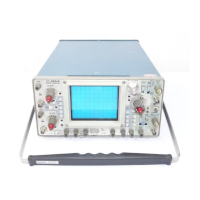Options— 465B
Service
Option 05
pulses in the vicinity of strong video transitions, or losing
sync pulses altogether To avoid overload problems,
use
external sync or use the other vertical channel to supply a
constant amplitude signal to the Sync Separator while the
overscanned observations are being
made
Note,
however, that transient-response
aberrations in the
main
vertical amplifier will
be
increased when
the
signal
is
driven offscreen, becoming relatively
serious if the
amplifier is driven
to
saturation
and cutoff
HORIZONTAL SYNC PULSE MEASUREMENTS. Rise
and fall times and width of horizontal sync pulses may be
measured while using the Sync Separator to determine
whether part or all of the lines or groups
of
lines appear to
be abnormal. A bright display of
all
horizontal sync
pulses
is
obtained when the A TRIGGER COUPLI NG switch is set
to
TV LINE
RF INTERFERENCE. Operation in the vicinity of
some
FM and TV transmitters may show objectionable amounts
of rf signal energy in the display, even when coaxial input
connections are
used.
The front-panel 20 MHz BW limit
switch will usually eliminate such interference from the
display, but will not affect the signal reaching the Sync
Separator Where the rf interferes with Sync Separator
operation,
external filters will be required. Use of probes
designed
for 10 to 30
MHz
oscilloscopes
will
provide 6 to
10 dB attenuation in the
50 to
100 MHz range and may
be
beneficial in reducing interference
IDENTIFYING
FIELDS, FRAMES, AND
LINES
IN 525/60 AND 625/50 TV SYSTEMS
NTSC
(CCIR System M)
Field 1 is defined
as
the
field whose first equalizing
pulse
is one full H interval
(63 5 microseconds) from the
preceding
horizontal sync pulse.
The
Field
1
picturestarts
with
a full line of video Field
1 lines are numbered
1
through 263. starting with
the leading edge
of
the first
equalizing
pulse. The first regular horizontal
sync pulse
after the second equalizing
interval is the start of line 10
Field 2 starts with an equalizing pulse
a
half-line interval
from the preceding horizontal sync pulse. The Field
2
picture starts with
a
half line
of video. Field 2 lines are
numbered 1 through
262.
starting with
the
leading
edge of
the second
equalizing
pulse. After the second equalizing
interval,
the
first full line is line
9
CCIR System B and
Similar 625/50
Systems
(including
PAL)
In most 625-line, 50
Hz field-rate systems,
identification
of parts of the
picture relies primarily on
continuous line
numbering
rather than on
field-and-line identification,
except for
PAL
systems
The CCIR frame starts with the first (wide)
vertical
sync
pulse following
a
field
which
ends with a half-li ne of video.
The first line after the second
equalizing
interval is
line
6;
the first
picture line is line
23
(half-line of video). The first
field of the frame contains
lines 1 through the first
half
of
line 313,
the picture ending with a full line of video (line
310).
The second field of the frame commences with the
leading edge of the first (wide) vertical sync
pulse (middle
of line
313),
and runs through line 625 (end of
equalizing
interval). The first
full
line
after the equalizing interval is
line
318;
the picture starts on line
336
(full line)
The first field
is
referred
to as "odd
".the second field
as
"even"
Note that the identification systems for System M
and System B are
reversed.
In the four-field PAL sequence with Bruch Sequence
Color-burst blanking, the fields are identified
as
follows:
Field 1: Field that follows
a
field ending in a half-line of
video, when preceding field has color burst on
the
last full line Field 1 lines are
1
through 312
and half
of
line 313 Color
burst
starts
on
line
7
of
Field
1; a
half-line of video appears on line 23.
Field
2: Field that follows a
field ending
in
afull line which
does
not carry color burst Field 2
lines are the
last half of line 313
through line 625 Color burst
starts
on line
319
(one line without
burst follow-
ing the
last equalizing pulse); a full line of
video
appears at line 336.
Field
3:
Field that
follows
a
field ending
in
a
half line when
preceding
field has no color burst on its
last full
line. Field 3 lines are
1 through thefirst
half
of
line
313. Burst starts
on line
6
(immediately following
the last equalizing
pulse);
a
half-line of video
appears
on line 23.
Field
4 Field that follows a
field ending in
a
full line
carrying color burst. Field
4 lines are the second
half of line 313 through line G25.
Color burst for
Field 4 starts on line 320 (two
full lines without
burst
follow the last equalizing pulse);
video
starts with a full
line on line 336
@
69

